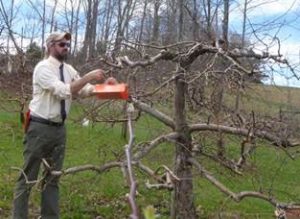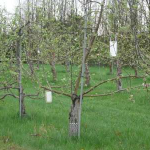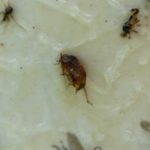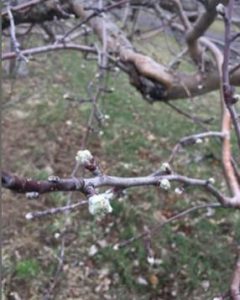As many growers know, we are rolling out an expanding orchard scouting program at select sites this year in cooperation with Eric Boire from CPS. This week I got to my sites, both ‘inland’ in Washington and Orange counties, and things were, as expected, behind the main production regions (half-inch green vs tight cluster). Growers in cooler sites still have time to apply oil at 1% by volume, maybe 1.5% if you’re really showing nothing past half-inch green. We are seeing a flare up of San Jose scale in Vermont orchards (just check out some apples from the grocery stores, they’re not hard to find), and a good coating of oil will go a long way toward managing them as well as the mites that we’ll inevitably see come summer.
Insect activity has been relatively low, although the higher temperatures yesterday afternoon may have incited a bit more activity than our traps have caught. Right now we’re looking mainly at tarnished plant bug, and of 40 traps across the state, we’ve only caught one on a TPB trap and another couple in nearby EAS traps- nowhere near treatment threshold. Green fruitworm is a pest that might flare up (and which we have no traps for) and a dose of soft material like Dipel or another Bt product would be good to have on-hand. One nice thing about Bt at this time of year is it’s very safe on bees, but as a lepidopteran (caterpillar)-specific material, it also has no activity against TPB or European apple sawfly, when (if) that one becomes a problem later on.
Apple scab season is here for everyone- keep protected with a protective fungicide going into any rains. Mancozebs, Captan (if no oil has been applied for 7 days before or after), sulfur if organic. Plan on using one of the ‘bigger gun’ materials at pink or petal fall, or immediately after a missed wetting event if that material has good kick-back activity (strobilurins, sterol inhibitors, or SDHIs). There is some evidence of toxicity of sterol inhibitors (Indar, Inspire Super, Procure, Rally, Vintage) to pollinators, to it is best used well before or after bloom when bees (managed and wild) are not visiting flowers.
My main reason for writing today is to get everyone thinking ahead about fire blight. Not panicking, not spraying indiscriminately, but preparing for the event should infection conditions arrive. In that case, you’ll need streptomycin (Harbor, applied at 2 lbs per acre) on-hand since you’ve got 24 hours to apply it after an infection event. Sorry organic growers, strep isn’t approved any more, but Serenade and some other biologicals that I don’t have experience with (Blossom protect, etc.) have some efficacy when applied during an infection event in bloom but not nearly as effective as strep. I expect bloom as early as mid-late next week, so you have time to get some on-hand but if you wait and the big orchards in northeastern New York order up enough material to cover their 2500+ acres (remember they had a FB outbreak last year), it will be in short supply. Any grower who had even a small amount of fire blight last year should have enough on-hand to hit those infected blocks plus susceptible cultivars (Cortland, Paulared, Gala, Honeycrisp) at a minimum, and ideally enough to treat thew whole orchard.
My recommendation to have strep on-hand is different than my recommendation on how to use it, so no one should be spraying strep right now or without consulting a model or hearing otherwise. The fire blight bacteria requires heat prior to and during a potential infection event to multiply and infect, and also requires fresh open wounds (or blossoms) and a few other factors. Until all of those pieces are in place, leave it on the shelf.
Where trade names or commercial products are used for identification,
no discrimination is intended and no endorsement is implied.
Always read the label before using any pesticide.
The label is the legal document for the product use.
Disregard any information in this message if it is in conflict with the
label.
The UVM Tree Fruit and Viticulture Program is supported by the
University of Vermont Agriculture Experiment Station, a USDA NIFA E-IPM
Grant, and USDA Risk Management Agency Funds.






